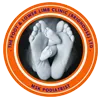
Why Your Ankles Keep Rolling: Understanding Chronic Ankle Instability
Have you ever stepped off a curb or walked on uneven ground and felt your ankle suddenly twist or give way? And not just once—but over and over again?
If this sounds familiar, you might be dealing with something called chronic ankle instability. It's more common than people think, and it can make everyday walking feel uncertain or even risky. But the good news is—there are ways to treat it and stop the cycle of repeated ankle injuries.
What is Chronic Ankle Instability?
Chronic ankle instability happens when the outside of your ankle keeps rolling, turning, or giving way—especially during movement. It usually starts after you've had a few ankle sprains that didn’t fully heal.
Over time, the ligaments around the ankle get weaker, and your balance and control can be affected. This makes it easier for the ankle to twist again… and again.
Why Does This Happen?
Here are a few common causes:
Past ankle sprains – If you’ve sprained your ankle in the past and didn’t get the right rehab, the joint can remain loose or weak.
Weakened ligaments – Ligaments are like strong elastic bands that hold your bones in place. If they get overstretched or torn, your ankle won’t be as stable.
Poor balance or coordination – Sometimes the brain and muscles don’t “talk” well after an injury, making it hard to react quickly and stay steady.
Foot shape or posture – High arches or rolling in too much (overpronation) can increase the chance of instability.
Signs You Might Have Chronic Ankle Instability
Your ankle rolls often, even during simple activities like walking or standing
You feel like your ankle is weak or might "give out"
You avoid certain sports or uneven ground because you're afraid of twisting your ankle
You have ongoing pain, swelling, or stiffness around the ankle
How Can a Podiatrist Help?
At The Foot & Lower Limb Clinic, we’ve helped many patients—athletes, walkers, and everyday people—regain confidence in their ankles.
Here’s how we typically support recovery:
1. Thorough Assessment
We start with a full check of your ankle strength, joint stability, balance, and foot alignment. This helps us understand exactly what’s going on.
2. Rehabilitation Exercises
We’ll guide you through a personalised rehab plan to strengthen the ankle, improve balance, and retrain how your body responds to movement.
3. Custom Orthotics
If your foot shape is contributing to the problem, custom orthotics can help align and support the ankle properly.
4. Advanced Treatment Options
For more severe cases, we might use bracing or discuss whether referral for imaging or surgical input is needed.
Don’t Let Wobbly Ankles Slow You Down
It might feel like a small thing—an ankle that rolls every now and then—but chronic instability can turn into long-term damage if it’s not treated. The earlier you get help, the easier it is to stop that cycle and get back to moving with confidence.
Worried About Your Ankles Giving Way?
We’re here to help. Whether it’s your first sprain or your tenth, let’s get your ankle strong, stable, and ready to support you again.
Visit us in Colne or Brighouse
Call today or book online for an assessment.


